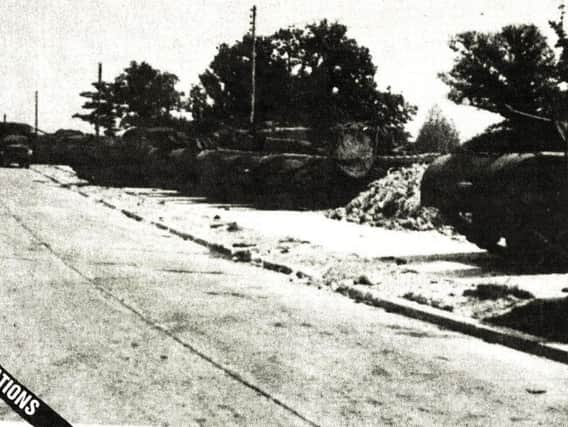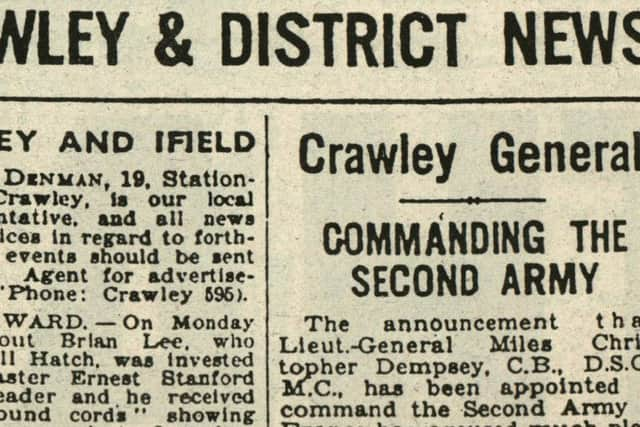D-Day was approaching, and we were in tank wonderland


With these words, General Bernard Montgomery sent the Allied army into battle on D-Day, June 6 1944.
Crawley played its role in the build-up to Operation Overlord - the codename for the Battle of Normandy - and was the home town of the commander of the Second Army.
Advertisement
Hide AdAdvertisement
Hide AdHundreds of tanks were stored along Crawley Avenue during Spring 1944, and several army units were based in the area.


The 8th Corps was at The Grove, Worth, the 8th Corps Rear HQ was stationed at Worth Priory, the 30th Corps were based at Milton Mount College, Three Bridges, and the 10th Survey Regiment were at Tilgate House.
A lad called Rex Williams was growing up in Crawley at the time. He would later go on to write a memoir called You Must Remember This, which told tales of wartime on the home front as seen through his eyes.
In 1994, on the 50th anniversary of D-Day, Rex shared some of the extracts from his work.
Advertisement
Hide AdAdvertisement
Hide AdHe wrote: “Sometime in the spring of 1944, we lads in Crawley thought Christmas had arrived early.


The army appeared and closed off half the bypass, all the southern side from the Tushmore roundabout to the bottom of Pease Pottage Hill.
Not only did they put up sentry boxes and a pole barrier at each roundabout access but they also built workshops for the REME (Royal Electrical and Mechanical Engineers).
Some of the concrete bases are still to be seen to this day. The reason for this activity became apparent when dozens of tanks and armoured vehicles arrived to be double parked on the road, cycle track and path and grass verge.
Advertisement
Hide AdAdvertisement
Hide AdThere was still not enough room so the fields were used also. The fields opposite my home, now called The Dingle, were filled.
It did not take us long to realise one young sentry could hardly supervise several hundred tanks. When we climbed in through the hatch and lowered ourselves inside, we were in wonderland.
The first thing to do was to adjust the periscope to keep an eye on the sentry.
The live shells were there for the gun. The cartridges all in place for the machine guns. A Colt revolver in a real leather holster. A Verey pistol and flares.
Advertisement
Hide AdAdvertisement
Hide AdI was in a Churchill tank one day and started the turret turning to the left. It was fascinating. I found the control and reversed it, trying to peer through the periscope at the same time. As it slowly turned back, there he was - the sentry - racing straight towards me.
I could gave shot him, I suppose, but decided instead to run for it!
He caught up with me as I was about to climb over the fence into a nearby garden, but do you know what? He hadn’t thought of anything to say!”
On D-Day, the tanks left and Rex woke up to a surprise.
He wrote: “I believe it was about 7.45am on June 6 1944. What on earth was all that noise?
Advertisement
Hide AdAdvertisement
Hide AdI ran into my parents’ room and looked out. Every single one of the tanks and other vehicles parked on the bypass and fields had gone. I certainly hadn’t heard them go.
I quickly ran down into the garden and looked up. There, flying south, was a magnificent sight. Halifax bombers towing two troop-carrying gliders each, Dakotas towing gliders, wave after wave of them.
Each aircraft had markings not seen by us before, broad white stripes under the wings and around the fuselage so that all could see they were on our side.
The ‘Longest Day’ had begun and many people who woke up that day would not see the sun set.
Advertisement
Hide AdAdvertisement
Hide AdMany locals were out of town that day. One, who lived just a mile away from me, was already in France. He was General Sir Miles Dempsey, the commander of the Second Army.”
He was in fact Lieut-General Miles Christopher Dempsey CB DSO MC, of Tredean, Goffs Park Road.
General Dempsey started the war as a Liet-Colonel, promoted to Colonel and acting Brigadier in November 1939. He led an infantry brigade through the campaign in France and Belgium and was promoted to acting Major-General in 1941.
By December 1942, he was Lieut-General and took over the 13th Corps of the Eighth Army, who were in action through Libya, El Alamein and on through Siciky to Italy and the German Winter Line.
Advertisement
Hide AdAdvertisement
Hide AdThe people of Crawley viewed the General’s conducted during the war with pride but also treasured the man behind the soldier.
A report in the Sussex and Surrey Courier stated: “Crawley will remember General Dempsey as an enthusiastic cricketer. He spent every hour possible on the Crawley cricket ground and developed into a very wily left-handed slow bowler and a fine right-handed batsman.”
Searching for the right school in Sussex for your child? - Visit educationsussex.com for authoritative reviews and so much more.